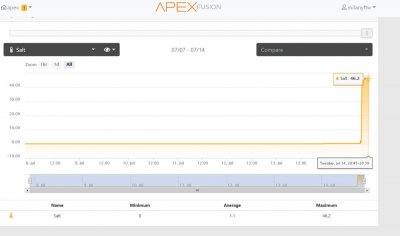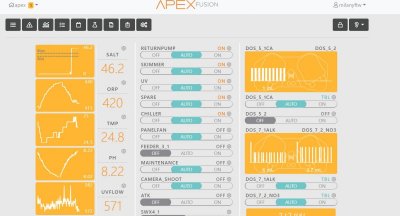@eag this is a great article thank you so much. Could you elaborate once you have set the TC to an initial value, how you figure our what is the correct TC? i.e. I set it to 2.2 but how can I tell if it should be 1.9 instead? what should I look for when playing around with it? Thanks
Navigation
Install the app
How to install the app on iOS
Follow along with the video below to see how to install our site as a web app on your home screen.
Note: This feature may not be available in some browsers.
More options
You are using an out of date browser. It may not display this or other websites correctly.
You should upgrade or use an alternative browser.
You should upgrade or use an alternative browser.
(Almost) Everything You Need to Know About Apex Salinity Calibration and TC Factor
- Thread starter eag
- Start date
- Tagged users None
@eag this is a great article thank you so much. Could you elaborate once you have set the TC to an initial value, how you figure our what is the correct TC? i.e. I set it to 2.2 but how can I tell if it should be 1.9 instead? what should I look for when playing around with it? Thanks
If the TC value is not correct, the salinity will still move around a bit, and may continue to be loosely correlated to temperature, just a lot less than before. In general, the "correct" TC value will result in the most stable salinity readings over time, since any other value would introduce noise on top of the actual salinity fluctuations. As a result, you should be able to move the value up or down and observe the salinity readings becoming more or less stable. Hope that makes sense - if not let me know and I will post a more detailed procedure on honing in.
Last edited:
Thanks, that makes sense. I will start playing around with it and observing the new trendIf the TC value is not correct, the salinity will still move around a bit, and may continue to be loosely correlated to temperature, just a lot less than before. In general, the "correct" TC value will result in the most stable salinity readings over time, since any other value would introduce noise on top of the actual salinity fluctuations. As a result, you should be able to move the value up or down and observe the salinity readings becoming more or less stable. Hope that makes sense - if not let me know and I will post a more detailed procedure on honing in.
- Joined
- May 16, 2017
- Messages
- 1,178
- Reaction score
- 1,050
Thanks @eag for this article. I've had my doubts about this based on the feedback I've read on this probe, but this may get me to try it in my (hopefully soon to be set up) next tank.
And this is the crux of my concern. If encrusting organisms and precipitant are problems, then it would seem the probe should be cleaned (with vinegar?) every so often (e.g. every month?). It seems that one would have to recalibrate after this?
Agreed @chipmunkofdoom2 .......... other products (e.g. American Marine's salinity monitor) are reportedly not as sensitive/more reliable. but they're not apex connected.
Yeah, I saw several threads on this. The probes do get precipitant, and sometimes they even get those little tube worm looking things in them. Although on the threads some claimed actual probe failure or pm2/brain failure. So if cleaning it did not fix the problem, it looks like it's either the probe or module/brain the probe is connected to.
And this is the crux of my concern. If encrusting organisms and precipitant are problems, then it would seem the probe should be cleaned (with vinegar?) every so often (e.g. every month?). It seems that one would have to recalibrate after this?
No wonder most people think the salinity probe is junk. There's a "gotcha" where you don't get TC if the TC factor is 0 when you install the salinity probe? TC is automatically set to zero because a non-zero value is unsafe if there's no temperature probe installed? The temperature probe and salinity probe absolutely must be installed on the same module, no exceptions? Am I understanding this correctly? That's kind of disgraceful.
I would expect this if we borrowed the Apex from the microbrewing or hydroponics industry and are trying to make it work in a use-case for which it wasn't designed. This is a controller that was (ostensibly) designed from the ground up to do nothing but monitor and control aquariums. It also retails for what is a mortgage/rent payment to a lot of people. You should be able to plug in the salinity probe, maybe tweak the TC and calibrate, then be done with it.
Agreed @chipmunkofdoom2 .......... other products (e.g. American Marine's salinity monitor) are reportedly not as sensitive/more reliable. but they're not apex connected.
Thanks @eag for this article. I've had my doubts about this based on the feedback I've read on this probe, but this may get me to try it in my (hopefully soon to be set up) next tank.
And this is the crux of my concern. If encrusting organisms and precipitant are problems, then it would seem the probe should be cleaned (with vinegar?) every so often (e.g. every month?). It seems that one would have to recalibrate after this?
Agreed @chipmunkofdoom2 .......... other products (e.g. American Marine's salinity monitor) are reportedly not as sensitive/more reliable. but they're not apex connected.
Neptune recommends them to be clean I believe quartley. So every 3 months I soak it in 50% vinegar 50% water for maybe 10 mins, then scrub gently with soft brush, then yes you need to recalibrate.
- Joined
- Jun 22, 2020
- Messages
- 55
- Reaction score
- 36
Hopefully someone can help. I did everything as recommended in the calibration steps. My salt readings are jumping around. It looked ok for a bit, but then it went crazy. I've installed the probe upside down as was advised in a different post. nothing seems to get the readings right.

Hopefully someone can help. I did everything as recommended in the calibration steps. My salt readings are jumping around. It looked ok for a bit, but then it went crazy.
There's a lot going on in that graph! If you could help to illustrate it a bit, that would be useful in trying to understand what is going on. What was happening at the time(s) of all those step functions? And the morning/afternoon of July 9?
- Joined
- Jun 22, 2020
- Messages
- 55
- Reaction score
- 36
Ok so on the 6th is when I got my probes calibrated and installed. On the 7th I added Spira bacteria. on the 8th I added a WAV power head, on the 9th I turned the probe upside down after the numbers got all crazy low. ORP has been increasing, ammonia is at half what it was on the 7th. I topped off with about a gallon of RO water yesterday. Lights have been off the entire time, skimmer is off. I'm using an HOB filter, the probes are placed away from the filter and about halfway down in the tank, I thought maybe bubbles were getting in there, so I moved it down to where I don't see any signs of bubbles at all and upside down.
Here are the latest graphs
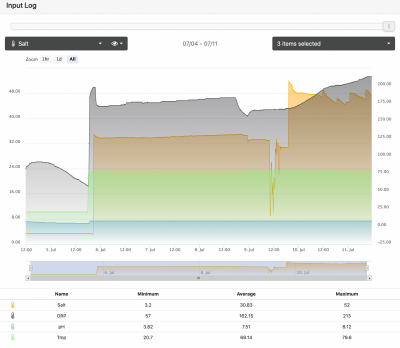
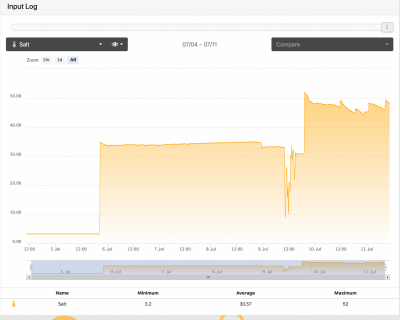
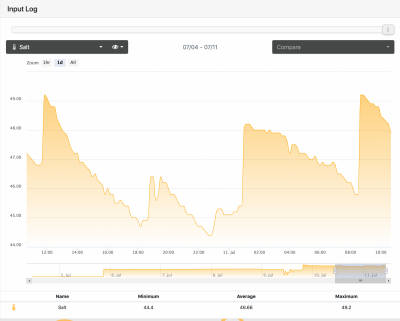
Here are the latest graphs



I’m thinking you didn’t follow something right
- Joined
- Oct 28, 2019
- Messages
- 166
- Reaction score
- 42
What is it ?I’m thinking you didn’t follow something right
My question is how long I should leave the TC to check accuracy before adjusting to another value?
- Joined
- Jun 4, 2016
- Messages
- 1,001
- Reaction score
- 455
If the TC value is not correct, the salinity will still move around a bit, and may continue to be loosely correlated to temperature, just a lot less than before. In general, the "correct" TC value will result in the most stable salinity readings over time, since any other value would introduce noise on top of the actual salinity fluctuations. As a result, you should be able to move the value up or down and observe the salinity readings becoming more or less stable. Hope that makes sense - if not let me know and I will post a more detailed procedure on honing in.
Great write-up. That whole TC has always been confusing and admitted I tweaked it randomly until I got to number that I liked. lol That was years ago and finally ready to re calibrate. Properly this time. =) I set the default 2.2 and did pH calibrations already. Planning to now do temperature and salt re calibration. Does that mean I need to go back and do pH again or are all these probes independent enough with maybe the exception of salt and temp.
Planning to now do temperature and salt re calibration. Does that mean I need to go back and do pH again or are all these probes independent enough with maybe the exception of salt and temp.
I don't know to be honest, but my understanding is that the current temperature is stored alongside the salinity calibration point. If that is the case, I'd expect the effect to be that everything continues working after a temp calibration, however the previous temperature-dependent calibration (e.g. salinity) will be calculating compensations based on the previously stored (and possibly incorrect) temperature.
It would be useful if you could test it out and see what happens
Excellent post. Thanks.I was trying to calibrate my new salinity probe a few weeks ago, and ran into all sorts of problems. Calibrations that were way off the mark, big fluctuations in readings that couldn't possibly be correct (and were verifiably not), etc. After searching around the internet, it was clear that a lot of folks have problems with this sensor. Some have written it off completely, and others insist that such problems are the result of calibration error. Information on correct calibration and configuration was present but scattered. Some of it was incomplete or incorrect. After having read many forum threads, spoken to Apex customer service, and experimented with different approaches, I am here to tell you that the sensor does work reliably when correctly configured and calibrated. This post is intended to capture everything I've learned in a single place, hopefully making this easier for someone else in the future.
Apex Configurables
There are only two configurable aspects of the Apex salinity sensor that can affect the reading. The first is, of course, the calibration point. The second is the temperature compensation factor (or TC factor). The salinity probe's readings are significantly affected by temperature - the TC factor setting allows you to compensate for this if you also have a temperature probe configured. The rest of this post captures the concepts and steps necessary to configure these inputs correctly.
TC Factor and Correctness
The TC factor configurable can be found on the advanced tab of the conductivity probe configuration page. It is a percentage, set manually - apparently different tanks land on different values. The percentage controls exactly how much compensation should be applied (i.e. x% compensation per degree).
One way to see if your TC factor is correct is by looking at your salinity graph with your temperature readings overlaid. If the TC factor needs to be adjusted, you will be able to see that the salinity readings track fluctuations in temperature. If the TC factor is correct(-ish), this correlation will not be present.
Here is what this looks like when TC is disabled (i.e. 0%):

Here is the same system with TC configured:

You can see from the first screenshot a clear correlation between temperature and salinity. Compare to the second screenshot with TC applied, and the salinity is relatively stable. I'm still not quite sure about those little bumps though. I continue to play around fine tuning the TC factor to see how they react (if at all - it's possible that the fluctuation is related to some funny business with my overflow).
Configuring the TC Factor
The TC factor defaults to 0. This is confusing for new Apex owners, as the salinity probe is all but worthless without applying temperature compensation. After speaking with customer service, and reading through some documentation, it appears that the default is 0 because setting it to anything other than zero causes problems in systems that don't have a temperature probe installed (the documentation includes a large WARNING section about this). Since Neptune cannot know or guarantee that any given system will have its temperature probe installed, the default is 0 to be safe.
If you have a temperature probe installed, you will definitely want to adjust the default TC factor. It is important to note that the temperature probe must be plugged into the same module as the salinity probe. In other words, if your salinity probe is plugged into your base unit, then you must also have a temperature probe plugged into the base unit. Similarly, if your salinity probe is plugged into a PM2 salinity module, then the temperature probe must be plugged into the same PM2.
TC Factor Value Range
It may take some experimentation to find the correct TC factor for your system. The Apex documentation states that seawater normally has a TC factor between 2.1% and 2.3%, thus recommending 2.2% as a good starting point. By comparison, a Neptune representative told me that in their experience, correct values are often found in the 1.9% to 2.1% range. Your mileage may vary.
The Apex documentation states that the salinity probe must be re-calibrated when changing the TC factor. According to a Neptune representative with whom I spoke, this is only partially true. When TC factor is non-zero and the salinity probe is configured, the current water temperature is stored inside the salinity calibration point that Apex records. This temperature is used to apply temperature compensation going forward. If the TC factor is zero when the salinity probe is configured, then the current water temperature is not stored, making future temperature compensation impossible. Therefor, in order for TC factor to take effect, it must be configured with a non-zero value at the time that the salinity probe is calibrated.
Fear not, however, in your search for the correct TC factor value. The Neptune representative informed me that once the salinity probe calibration point includes temperature data, the TC factor value can be changed at will without requiring re-calibration. Changes to the TC factor will be applied to all salinity readings going forward - readings that were taken in the past will not change.
How to Configure TC Factor for the First Time
Calibrating Salinity
- Ensure that a temperature probe is plugged into the same module as your salinity probe
- Navigate to the `Advanced` tab of the salinity probe configuration
- Change the TC factor value to any non-zero positive number (2.1 is a good starting point)
- Click "Update Apex" in the top right corner to upload the new configuration
- Perform a salinity calibration
- Salinity readings going forward will now have temperature compensation applied accordingly
There are a number of factors that require attention when calibrating the salinity probe. If any one of them are ignored, the resulting readings will be incorrect. Some of these are described in the documentation, and some are not.
We have learned that salinity readings are affected by temperature. As a result, temperature plays a very important part in the calibration process. When temperature compensation is disabled, and the Apex salinity calibration solution is used (the grey pouch, 53,000 microsiemens), the temperature during calibration is assumed to be 77.0 degrees fahrenheit. This is rarely actually the case, and folks calibrating their salinity probes who aren't aware of this detail will almost certainly experience inaccurate readings.
If however, you have a temperature probe, you do not need to warm the calibration solution to precisely 77.0 degrees. Apex will instead calibrate the salinity using the temperature reading provided by the probe. Note that this still means that the solution must be at precisely the same temperature as the probe! To accomplish this, you can simply float the calibration solution pouch in water near the temperature probe location for 15 minutes. Note that the calibration solution temperature can change rapidly - for instance, holding the pouch in your hand while performing the calibration will affect the accuracy. Be sure to keep the pouch in the water during the entire calibration process to ensure that the solution temperature doesn't deviate.
How to Calibrate Salinity
Note that the manual calibration process might work here as well, though I've never done that and so have no idea what it does or doesn't involve
- Ensure that your TC factor has already been configured with a non-zero value
- Float the calibration solution pouch near your temperature probe for 15 minutes
- Navigate to the `Basic` tab of the salinity probe configuration
- Click `Automatic Calibration`
- When asked to dry the salinity probe, remove it from the water and rinse with RO/DI. Then gently shake the probe, and pat the bottom dry with a paper towel
- When asked to insert the salinity probe into the calibration solution, open the pouch and insert the probe. Be sure to keep the pouch submerged in water during this process so the temperature remains stable
- Gently shake the probe in the calibration solution to remove any bubbles that might be trapped. This step is VERY important - shake for a little longer than you might otherwise
- Wait for the readings to stabilize, and complete the calibration. You're all done!
Finding More Information
I spent several days searching for information on this topic. This post is, as far as I know, the most complete source of information on Apex salinity calibration and temperature compensation currently available. As a new Apex owner, I was shocked to find that none of this information was included in any of the documentation I could find. When asking Neptune customer support about this, they referred me to the PM2 documentation. There is definitely more information there than the "regular" Apex docs, however it is still not complete and does not fully apply to the use of the base module for salinity readings.
If you find that any of the information in this post is inaccurate, or if you have information that is not included here but should be, please post a comment on this thread!!
Summary
I have found the Apex salinity sensor to be relatively accurate when correctly configured. Of particular importance is configuring temperature compensation, ensuring stable temperature conditions during calibration, and ensuring the correct order of operations. I hope that others who may be struggling with their Apex salinity sensor are able to use this thread to fix things up. Happy reefing!
Maybe you could help me with the following question
I have Apex salinity probe. Freshly calibrated with neptune 35ppm solution. After calibration my aquarium salinity reads 35.5p via the apex probe.
Hanna digital salinity, calibrated with hanna 35ppm special solution. The checker reads the hanna solution at 35. Same aquarium, it reads as 31ppm.
Milwaukee digital refractometer. Calbirated.
Reads my aquarium at 24 ppm
How can it be?
Which one shall I trust?
Excellent post. Thanks.
Maybe you could help me with the following question
I have Apex salinity probe. Freshly calibrated with neptune 35ppm solution. After calibration my aquarium salinity reads 35.5p via the apex probe.
Hanna digital salinity, calibrated with hanna 35ppm special solution. The checker reads the hanna solution at 35. Same aquarium, it reads as 31ppm.
Milwaukee digital refractometer. Calbirated.
Reads my aquarium at 24 ppm
How can it be?
Which one shall I trust?
Have the same problem.
Apex Probe
Hanna Salinity Tester
BRS Refractometer
Tropic Marin High Precision Hydrometer
All different readings, which one do I trust?
I was having a discrepancy between my Hanna and the Neptune after calibrating Apex with the Neptune solution. I tried testing the Neptune solution with the Hanna and found it was "off" by a few ppt in the opposite direction.
So it probably boils down to who do you believe more... Hanna or Neptune for their calibration solution. I decided I trusted Hanna for accuracy since it is NIST traceable (says it on the pouch). I adjusted my aquarium to 35 ppt on the dot with my Hanna. Then I calibrated the APEX probe using my aquarium water (do the dry step, then put it right in the probe rack for the 53k test).
I am not advocating Neptune or Hanna as better in terms of accuracy, I just chose Hanna as my "standard reference" because the pouch literally says it is NIST traceable vs Neptune not mentioning that.
So it probably boils down to who do you believe more... Hanna or Neptune for their calibration solution. I decided I trusted Hanna for accuracy since it is NIST traceable (says it on the pouch). I adjusted my aquarium to 35 ppt on the dot with my Hanna. Then I calibrated the APEX probe using my aquarium water (do the dry step, then put it right in the probe rack for the 53k test).
I am not advocating Neptune or Hanna as better in terms of accuracy, I just chose Hanna as my "standard reference" because the pouch literally says it is NIST traceable vs Neptune not mentioning that.
To accomplish this, you can simply float the calibration solution pouch in water near the temperature probe location for 15 minutes. Note that the calibration solution temperature can change rapidly - for instance, holding the pouch in your hand while performing the calibration will affect the accuracy. Be sure to keep the pouch in the water during the entire calibration process to ensure that the solution temperature doesn't deviate.
So what I came across on the Neptune forums from someone who had been talking to Neptune support, was to put the temperature probe in the solution with the conductivity probe.
The solution bag is so small that the temperature fluctuates rapidly. If you put the temp probe in the bag, you’ll actually see this. I must have really warm hands, because when I tried to keep the temp probe in the tank, I’d always end up 2-3ppt higher on the calibration.
Also I think you need to make sure your temp probe and conductivity probe are in the same location. For instance if your temp probe happens to be next your submersible pump which is putting out a lot of heat, and the conductivity probe is on the other side of the sump, your readings are probably going to be off.
So my calibration routine which gets me spot on with refractometer calibrated with 35ppt solution is as follows.
First if the probes are encrusted or dirty, I’ll do a vinegar or citric acid soak to clean them. Once clean, rinse both the temp probe and conductivity probe with RO/DI water. Gently shake off both probes and let them dry for about 15 minutes.
Next place the temp probe in a fresh 53,000 solution. I usually wait till I see the temperature on the dashboard react. Next I start a manual calibration. With the conductivity probe clean and dry you should see a fairly low number, and one that doesn’t change at all. If it’s changing it’s probably either not clean or dry yet.
When you get to the step to insert the probe in the 53,000 solution, make sure you really wait till you’ve got a stable number. I try and gently swirl the pouch to make sure any trapped bubbles get out. I also try not to shift my hands on the pouch too much. It’s not clear how fast the temperature readings adjust, so I don’t want a lot of temp fluctuations.
Once the calibration is complete, put the probes back in the tank next to each other, and let the temp readings readjust. At that point you should get an accurate salinity reading.
- Joined
- Jun 26, 2020
- Messages
- 435
- Reaction score
- 332
So do you use the calibration solution out of the water? So you don’t temp acclimate the solution at all right? Just put the temp probe in the bag itself out of the sump? I think that’s a good idea. I will try once I get more calibration solutionSo what I came across on the Neptune forums from someone who had been talking to Neptune support, was to put the temperature probe in the solution with the conductivity probe.
The solution bag is so small that the temperature fluctuates rapidly. If you put the temp probe in the bag, you’ll actually see this. I must have really warm hands, because when I tried to keep the temp probe in the tank, I’d always end up 2-3ppt higher on the calibration.
Also I think you need to make sure your temp probe and conductivity probe are in the same location. For instance if your temp probe happens to be next your submersible pump which is putting out a lot of heat, and the conductivity probe is on the other side of the sump, your readings are probably going to be off.
So my calibration routine which gets me spot on with refractometer calibrated with 35ppt solution is as follows.
First if the probes are encrusted or dirty, I’ll do a vinegar or citric acid soak to clean them. Once clean, rinse both the temp probe and conductivity probe with RO/DI water. Gently shake off both probes and let them dry for about 15 minutes.
Next place the temp probe in a fresh 53,000 solution. I usually wait till I see the temperature on the dashboard react. Next I start a manual calibration. With the conductivity probe clean and dry you should see a fairly low number, and one that doesn’t change at all. If it’s changing it’s probably either not clean or dry yet.
When you get to the step to insert the probe in the 53,000 solution, make sure you really wait till you’ve got a stable number. I try and gently swirl the pouch to make sure any trapped bubbles get out. I also try not to shift my hands on the pouch too much. It’s not clear how fast the temperature readings adjust, so I don’t want a lot of temp fluctuations.
Once the calibration is complete, put the probes back in the tank next to each other, and let the temp readings readjust. At that point you should get an accurate salinity reading.
Similar threads
- Replies
- 2
- Views
- 69
- Replies
- 5
- Views
- 365
- Replies
- 13
- Views
- 307





